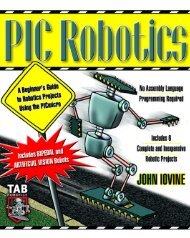You also want an ePaper? Increase the reach of your titles
YUMPU automatically turns print PDFs into web optimized ePapers that Google loves.
1.0 IntroductionThe objective of our EECE474 project is to design a Pac-Man game involving a remotecontrol system that is suitable for children who are six years old and above. The idea ofthis project comes from the computer game Pac-Man. The rules and the features of ourproject are similar to the computer game.Our goals are to implement two wireless and motor running <strong>robot</strong>s and to set up a gamesetting, while maintaining the same features as in the computer game. The featuresinclude the fact that Pac-Man keeps score of the number of dots collected, the Ghosttraces Pac-Man and finds the shortest path to it, and that the Ghost travel at a speed fasterthan Pac-Man.The project involves two <strong>robot</strong>s – Pac-Man and Ghost. In general, the objective of thegame is for players to control Pac-Man’s movements within the maze with a wirelesscontroller. Pac-Man must eat all the dots on the maze and avoid contact with the Ghost atthe same time. Pac-Man is given three lives. If Pac-Man comes into contact with theGhost three times before eating all the dots, the game is pronounced over.Our Pac-Man <strong>robot</strong> consists of the following systems:1) an RF system that receives directional instructions from users2) a wall detection system3) a score keeping system4) a motor system5) a contact sensor that detect contacts with the Ghost.The Ghost is an autonomous <strong>robot</strong> that is:1) able to detect walls2) to automatically traverse the maze3) to locate and catch Pac-Man4) to detect contact with Pac-Man.Our project is divided into two main components – hardware and software. Both thehardware and the software are further broken down into several individual subsystems.Each subsystem is tested and implemented separately, and integrated together toconstruct our final project. The testing results and the design processes of eachsubsystem are discussed in detail in the following sections. In addition, problemsencountered and the solutions are described.1




